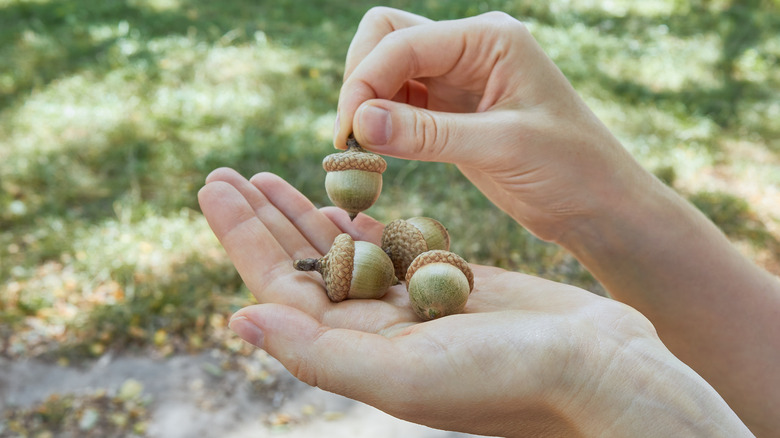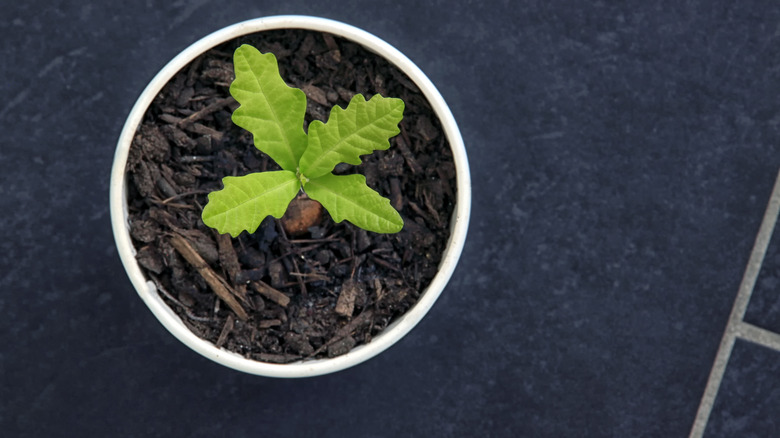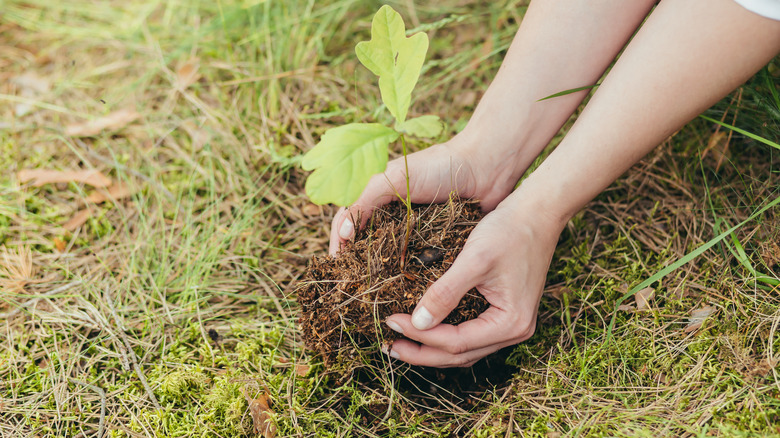Tips For Planting An Acorn To Grow A Stunning Oak Tree
When you look up into the canopy of a shady oak tree, it can be hard to imagine how such a giant organism grew from one small acorn. Understanding how rare it is for an acorn to germinate makes this sight even more jaw-dropping. On average, a 100-year old oak tree can produce about 2,200 acorns every year. Every two to five years, oak trees may also experience a "mast year," a sudden increase in production with acorns totaling up to 10,000. Of course, not every acorn will turn into an oak tree. An acorn requires special conditions to be met before it can germinate and grow, so only about one in every 10,000 acorns will become an adult tree. To grow an oak tree, you'll need to start by selecting a viable acorn, then plant it in a pot and carefully water the seedling before transferring it to your yard. Some oaks may also need to undergo cold stratification, either outdoors or in your refrigerator.
If you're trying to establish a beautiful oak on your property, you'll need to do more than just pop the acorn into the soil. Luckily, growing an oak tree from an acorn isn't too difficult if you know the right tips for your specific oak. Here's how you can foster the right growing conditions for your acorns, germination techniques for the different types of oak trees you can plant in your yard, and tips for growing and transplanting your oak sapling.
Select and start your acorns wisely
The first thing you should do with those fallen acorns in your yard is drop them into a bucket of water. Any acorns that float are most likely unviable, so scoop them out and hang on to the ones that sink. For the best results, it's good to plant your acorns in a pot outdoors where you can keep an eye on them and have some amount of control over the growing conditions. Choose a starter pot that is at least 3 ½ inches deep, then set the acorns on their side before planting them about ½ to 1 inch deep in the soil. Water the acorns thoroughly after planting and keep them in a bright, sunny location to encourage the plant's main taproot to grow.
Acorns themselves aren't actually the whole seeds; they're a tough shell that protects the delicate seed inside. Some varieties like pin oak, red oak, and bur oak must sit through the wet, cold winter to experience stratification, which brings the acorn out of dormancy. If you want to start your oaks sooner, you can mimic this process by storing the acorns in the refrigerator in a container of sand and peat moss for 30 to 60 days, depending on the oak variety. If you decide to plant these varieties outdoors in the fall, keep the soil moist until winter sets in, then wait to water again until spring.
Protect and care for your tender sapling
White oak and swamp oak, for example, will germinate soon after they're planted in the fall, but as previously noted, pin oak, red oak, and bur oak trees need a chilling period before germination, so you can expect to see these seedlings emerge in the following spring. Once the seedlings reach about 5 inches tall, they'll likely be ready to transplant into a larger pot. To give these growing plants an extra boost, add about 1 teaspoon of slow-release fertilizer into their new potting mixture. During this time, you may need to keep a net or wire mesh around your seedling to protect it from deer and other wildlife.
Learning how to grow and care for oak trees is a rewarding process, but it can take a long time; seedlings may need care for about one to two years before they're ready to be transplanted into their forever home in your yard. It's best to repot your seedling or move it into your yard while the tree is dormant to reduce stress, so aim to transplant in late fall or early spring. As the tree grows, water about 2 inches per week and keep a ring of mulch around the base to protect the seedling from frost, weeds, and dehydration, ensuring that the mulch stays about 2 inches away from the oak's trunk. In the first few years of growth, a gentle, nitrogen-rich fertilizer can help the plant stay healthy.


